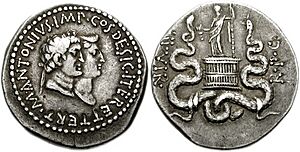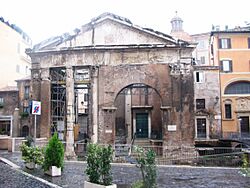Octavia the Younger facts for kids
Quick facts for kids Octavia Minor |
|
|---|---|
 |
|
| Born | c. 66 BC Nola, Italy, Roman Republic |
| Died | 11 BC (aged c. 55) Rome, Italy, Roman Empire |
| Burial | Mausoleum of Augustus |
| Spouse |
|
| Issue |
|
| Dynasty | Julio-Claudian |
| Father | Gaius Octavius |
| Mother | Atia |
Octavia the Younger (Latin: Octavia Minor; born around 66 BC – died 11 BC) was a very important woman in ancient Rome. She was the older sister of Augustus, who became the first Roman emperor. She was also the fourth wife of Mark Antony, a famous Roman general and politician.
Octavia was a great-grandmother to Emperor Caligula and Empress Agrippina the Younger. She was also the grandmother of Emperor Claudius and a great-grandmother to Emperor Nero. People in her time respected and admired Octavia for being loyal, noble, and kind. She was also known for showing the traditional Roman qualities expected of women.
Contents
Octavia's Early Life and Family
Her Childhood Years
Octavia was born around 66 BC in Nola, which is in modern-day Italy. Her father, Gaius Octavius, was a Roman governor and senator. He died when Octavia was only about seven years old.
Octavia's mother, Atia, later married Lucius Marcius Philippus. Octavia spent much of her childhood traveling with her parents. Her stepfather, Marcius, helped educate both Octavia and her younger brother, Octavian, who later became Emperor Augustus.
Octavia's First Marriage
Before 54 BC, Octavia's stepfather arranged for her to marry Gaius Claudius Marcellus. He was from a powerful Roman family. At the time of their marriage, Octavia would have been between 12 and 15 years old.
In 54 BC, Octavia's great-uncle, Julius Caesar, wanted her to divorce Marcellus. He hoped she would marry Pompey, another powerful Roman leader. However, Octavia and Marcellus did not want to divorce. Pompey also declined the idea and married someone else.
Marcellus was a friend of Cicero, a famous Roman speaker. He was against Julius Caesar when Caesar invaded Italy in 49 BC. However, Marcellus did not fight against Caesar and was later forgiven. Octavia and Marcellus had three children who survived: Claudia Marcella Major, Claudia Marcella Minor, and Marcus Claudius Marcellus. Her husband, Marcellus, died in May 40 BC.
Octavia's Second Marriage to Mark Antony
In October 40 BC, the Roman Senate approved Octavia's marriage to Mark Antony. This was his fourth marriage. Antony's previous wife, Fulvia, had recently died. This marriage was a political move to strengthen the difficult alliance between Octavia's brother, Octavian, and Mark Antony.
Octavia was a loyal and faithful wife to Antony. From 40 to 36 BC, she traveled with him to different Roman provinces. They lived together in his home in Athens. There, she raised her children from her first marriage, as well as Antony's two sons from a previous marriage. She also gave birth to two daughters with Antony: Antonia Major and Antonia Minor.
Challenges and Divorce
The alliance between Octavian and Antony faced big problems when Antony left Octavia and their children. He chose to be with Cleopatra VII, the Queen of Egypt. Antony and Cleopatra had met in 41 BC and had twins together.
After 36 BC, Octavia returned to Rome with her daughters. She often acted as a political advisor and helped negotiate between her husband and her brother. For example, in 37 BC, she helped arrange an important agreement. Antony and Octavian agreed to help each other in their military campaigns. Octavia was praised as a "marvel of womankind" for her efforts.
In 35 BC, Antony had a difficult military campaign. Octavia brought fresh troops, supplies, and money to him in Athens. But Antony sent her a letter telling her not to come any further. Mark Antony divorced Octavia in late 33 BC. He also sent men to remove her from his house in Rome.
Octavia then became the sole caregiver for all her children. After Antony died in 30 BC, her brother Octavian allowed Octavia to raise Antony's younger son by Fulvia. She also raised Antony's children by Cleopatra.
Octavia's Later Life and Honors
In 35 BC, Augustus gave many special honors and privileges to Octavia and his wife, Livia. These honors were very unusual for women in Rome at the time. They were given sacrosanctitas, which meant it was illegal to insult them. This protection had only been given to male officials before.
Livia and Octavia were also made immune from tutela. This meant they did not need a male guardian to manage their money, which most Roman women did. They were also the first women in Rome to have many statues and portraits displayed in public places. Octavia was featured in Augustus's rebuilding of Rome.
Augustus loved Octavia's son, Marcellus, very much. However, he never officially adopted him. When Marcellus died unexpectedly in 23 BC, Augustus was very sad. Octavia was heartbroken and struggled greatly with her grief.
A story says that the famous poet Virgil read parts of his epic poem, the Aeneid, to Augustus and Octavia. When Virgil read lines about Octavia's son, Marcellus, she fainted from sadness. It is said that she sent Virgil a large sum of money for each of those verses.
Octavia may have never fully recovered from her son's death. She mostly stayed out of public life, except for important events. She publicly opened the Library of Marcellus, which was built in his memory. Her brother also finished building Marcellus's theater in his honor. Octavia likely attended both ceremonies. She was also consulted about her brother's daughter, Julia, marrying Agrippa.
Octavia's Death and Legacy
Octavia died of natural causes in 11 BC, when she was about 55 years old. Her funeral was a public event. Her sons-in-law carried her to her burial place in the Mausoleum of Augustus.
Augustus gave his sister the highest honors after her death. He built the Gate of Octavia and the Porticus Octaviae in her memory. He also had the Roman Senate declare his sister a goddess. Octavia was one of the first Roman women to have coins made with her image on them.
Octavia's Children
Children with Gaius Claudius Marcellus
Octavia and her first husband had one son and two daughters who lived to adulthood:
- Marcus Claudius Marcellus
- Claudia Marcella Major
- Claudia Marcella Minor
Children with Mark Antony
Octavia and Mark Antony had two daughters. Both of them became ancestors of later Roman emperors:
- Antonia Major: She was the grandmother of Emperor Nero.
- Antonia Minor: She was the mother of Emperor Claudius, the grandmother of Emperor Caligula, and the great-grandmother of Emperor Nero.
Important Descendants
Three Roman emperors, Caligula, Claudius, and Nero, were among Octavia's most famous descendants. Her family tree shows how connected she was to the future leaders of Rome.
- Octavia the Younger
- Marcus Claudius Marcellus (42 BC – 23 BC), no children
- Claudia Marcella Major (born 41 BC)
- Vipsania Marcella Major
- Vipsania Marcella Minor
- Iullus Antonius (? – ?), children unknown
- Lucius Antonius (20 BC – AD 25), children unknown
- Iulla Antonia (? – ?), children unknown
- Claudia Marcella Minor (born 40 BC)
- Paullus Aemilius Regulus (? – ?), children unknown
- Claudia Pulchra (14 BC–26)
- Marcus Valerius Messala Barbatus (11 BC – 20/21)
- Marcus Valerius Messalla Corvinus (? – ?), possibly son of Aurelius Messalinus
- Valeria Messalina (17 AD or 20 AD – 48 AD)
* Claudia Octavia (39 AD or 40 AD – 62 AD), no children
*- Tiberius Claudius Caesar Britannicus (41 AD – 55 AD), no children
-
-
- Valeria Messallia (c. 10 BC – ?)
- Lucius Vipstanus Poplicola (c. 10 – after 59)
- Valeria Messallia (c. 10 BC – ?)
-
-
- Gaius Valerius Poplicola (? – ?), children unknown
-
-
-
- Gaius Vipstanus Messalla Gallus (c. 10 BC – after 60)
-
-
-
- Lucius Vipstanus Messalla (c. 45 – c. 80) **
- Lucius Vipstanus Messalla (c. 75 – after 115)
-
- Antonia Major (39 BC – before 25 AD)
- Domitia Lepida the Elder (c. 19 BC – 59 AD)
- Quintus Haterius Antoninus (? – ?)
- Gnaeus Domitius Ahenobarbus (17 BC – 40 AD)
 Nero Claudius Caesar Augustus Germanicus (Lucius Domitius Ahenobarbus) (37 AD – 68 AD)
Nero Claudius Caesar Augustus Germanicus (Lucius Domitius Ahenobarbus) (37 AD – 68 AD)
- Domitia Lepida the Elder (c. 19 BC – 59 AD)
- Antonia Major (39 BC – before 25 AD)
-
- Claudia Augusta (January 63 AD – April 63 AD), died young
-
-
- Domitia Lepida the Younger (10 BC – 54 AD)
- Marcus Valerius Messalla Corvinus (same man as above), possibly son of Aurelius Messalinus or Valerius Barbatus (same man as above)
- Valeria Messalina (same woman as above)
- Domitia Lepida the Younger (10 BC – 54 AD)
-
-
- See her line above
-
-
-
- Faustus Cornelius Sulla Felix (22 AD – 62 AD)
-
-
-
- A son, died young
-
- Antonia Minor (36 BC – 37 AD)
- Germanicus Julius Caesar (15 BC – 19 AD)
- Nero Julius Caesar Germanicus (6 AD – 30 AD), no children
- Drusus Julius Caesar Germanicus (8 AD – 33 AD), no children
- Tiberius Julius Caesar Germanicus (born between 7 and 12 AD), died as an infant
- Ignotus (born between 7 and 12 AD), died as an infant
- Gaius Julius Caesar Germanicus Major (born between 7 and 12 AD), died in childhood
 Gaius Julius Caesar Augustus Germanicus (Caligula) (12 AD – 41 AD)
Gaius Julius Caesar Augustus Germanicus (Caligula) (12 AD – 41 AD)
- Germanicus Julius Caesar (15 BC – 19 AD)
- Antonia Minor (36 BC – 37 AD)
-
- Julia Drusilla (39 AD – 41 AD), died young
-
-
-
- Julia Agrippina (Agrippina Minor) (15 AD – 59)
-
-
-
 Nero Claudius Caesar Augustus Germanicus (Lucius Domitius Ahenobarbus) (same man as above) **
Nero Claudius Caesar Augustus Germanicus (Lucius Domitius Ahenobarbus) (same man as above) **- See his line above
-
-
-
- Julia Drusilla (16 AD – 38 AD), no children
- Julia Livilla (18 AD – 42 AD), no children
- Claudia Livia Julia (Livilla) (13 BC – 31 AD)
- Julia Livia (7 AD – 43 AD)
-
-
-
- Rubellius Drusus (? – ?), children unknown
-
-
-
- Tiberius Julius Caesar Nero Gemellus (19AD – 37 AD or 38 AD), no children
- Tiberius Claudius Caesar Germanicus II Gemellus (19 AD – 23 AD), died young
 Tiberius Claudius Caesar Augustus Germanicus (10 BC – 54 AD)
Tiberius Claudius Caesar Augustus Germanicus (10 BC – 54 AD)
- Tiberius Claudius Drusus, died young
- Claudia Antonia (c. 30 AD – 66 AD)
-
-
-
- A son, died young
-
-
-
- Claudia Octavia (same woman as above)
- Tiberius Claudius Caesar Britannicus (same man as above)
-
-
-
Octavia in Art and Media
A famous story tells how the poet Virgil read a part of his poem that praised Octavia's son Marcellus. Octavia was so sad that she fainted. This story has inspired many artworks.
- The painting Virgil reading The Aeneid before Augustus, Livia and Octavia by Jean-Auguste-Dominique Ingres (1812) is a famous example.
- Other artists like Jean-Joseph Taillasson, Antonio Zucchi, and Angelica Kaufmann have also painted this scene.
Octavia's later life, especially around the time Marcellus died, is shown in the 1976 TV show I, Claudius. Angela Morant played Octavia in this series.
In the 1963 film Cleopatra, Jean Marsh played Octavia in a small role.
A made-up version of Octavia's early life appears in the 2005 TV series Rome.
In the TV series Domina (2021), Octavia was played by Alexandra Moloney and Claire Forlani.




